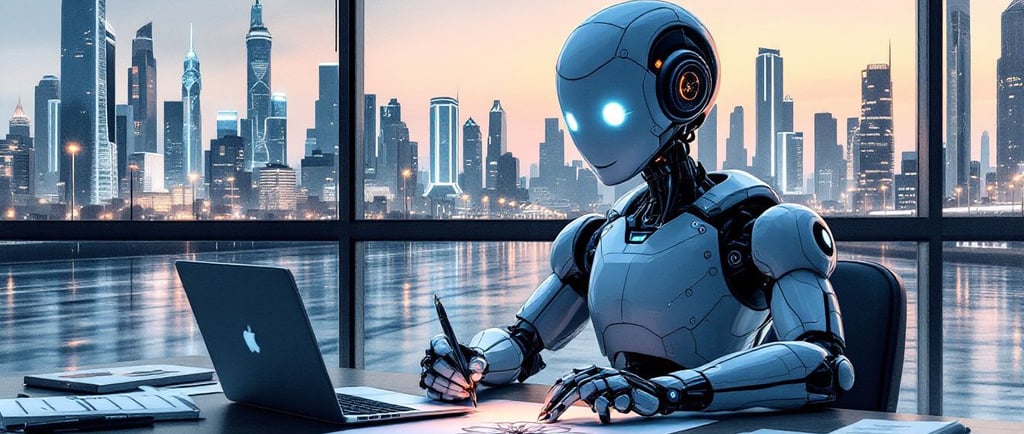Agentic AI in Content Creation: Balancing Automation and Creativity
How AI-Powered Agents Are Transforming Digital Media, Marketing, and Artistic Expression
Arpit Singh
1/26/20252 min read


How AI-Driven Autonomous Agents Are Transforming Digital Content
Content creation is no longer solely a human-driven process. Agentic AI—AI that can autonomously generate, optimize, and personalize content—has become a game-changer for businesses, marketers, and creators. But while AI-driven automation is accelerating content production, the question remains: Can it truly replace human creativity?
The answer lies in balancing automation with human ingenuity. AI is not just a tool for mass-producing articles, videos, or social media posts—it is a collaborative assistant that enhances creativity, speeds up ideation, and tailors content for maximum engagement.
How Agentic AI is Transforming Content Creation
✅ AI-Powered Writing & Blog Generation
Traditional content creation involves hours of research, drafting, and revisions. Agentic AI automates these tasks by generating high-quality, SEO-optimized content based on audience preferences, trending topics, and keyword analysis.
🔹 Example: OpenAI’s ChatGPT assists in writing blog posts, whitepapers, and reports, offering real-time editing and content refinement.
🔹 Impact: Writers can focus on storytelling, while AI handles research, structuring, and SEO.
✅ Automated Video & Image Generation
AI is transforming video production, graphic design, and image creation, enabling brands to generate high-quality content with minimal effort.
🔹 Example: Runway ML and Synthesia use AI to create hyper-realistic videos featuring AI-generated avatars, reducing production time and cost.
🔹 Impact: Businesses can scale content production while maintaining quality and brand consistency.
✅ Personalized Content at Scale
Agentic AI analyzes user behavior, preferences, and engagement patterns to generate tailored content for different audiences.
🔹 Example: Netflix’s AI recommendation engine personalizes thumbnails, descriptions, and previews based on a user’s watch history.
🔹 Impact: Higher engagement rates, improved retention, and a customized user experience.
The Role of AI in Creative Industries
🎨 Graphic Design & Branding
Designers are leveraging AI to streamline repetitive tasks like color correction, font selection, and image enhancement.
🔹 Example: Adobe Sensei assists graphic designers by automating background removal, image resizing, and content-aware edits.
🎶 Music Composition & Sound Design
AI-generated music is redefining the music industry, offering instant compositions for videos, games, and ads.
🔹 Example: AIVA composes orchestral and electronic music using deep learning models.
📱 Social Media Content Automation
Brands use AI-powered tools to schedule posts, optimize captions, and generate dynamic social media content.
🔹 Example: Hootsuite AI recommends the best times to post and suggests content improvements for higher engagement.
Challenges of AI in Content Creation
Despite its advantages, AI-generated content comes with ethical and creative challenges:
Loss of Human Creativity – AI can generate content, but it lacks human intuition, emotions, and cultural nuances.
AI Bias & Ethical Concerns – AI models can reproduce biases found in training data, leading to problematic content generation.
Over-Reliance on AI – Businesses may risk losing brand authenticity if content is overly automated.
The Future of AI-Assisted Creativity
According to Gartner, by 2027, over 90% of content on the internet will be AI-generated—but human oversight will remain essential to ensure originality and brand identity.
The future will feature:
🔹 AI-assisted storytelling, where human writers guide AI to create emotionally resonant content.
🔹 AI-driven interactive media, blending AI-generated videos with real-time audience engagement.
🔹 Ethical AI content frameworks, ensuring that AI-generated content remains fair, unbiased, and culturally appropriate.
Final Thoughts: How to Balance AI and Human Creativity
AI is not replacing creativity—it’s augmenting it. Businesses and creators that integrate AI as a collaborative tool will increase efficiency while maintaining a human touch.
The best approach is a hybrid model, where AI handles data-heavy, repetitive tasks, and humans focus on storytelling, strategy, and emotional intelligence—ensuring content remains authentic and engaging.
🔗 Further Reading: The Ethics of AI in Content Creation
Get in touch
Address
RG Trade Tower
Netaji Subhash Place, Pitampura, Delhi, 110034
Contacts
+91 97110 93598
info@quantackle.com
